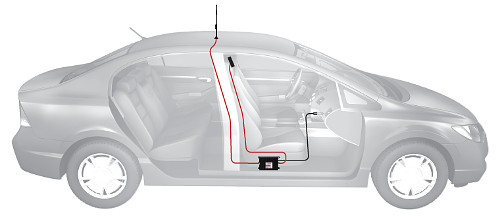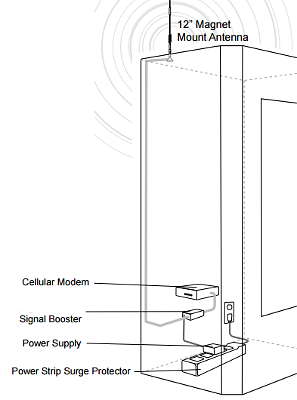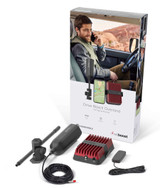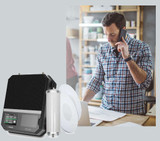Intro To Cellular Signal Boosters Systems
There are a variety of cell phone signal boosters that will improve the signal to your cell phone. Booster systems enable you to make calls in weak signal areas where you couldn't before. They will also improve the Internet speed of your phone. This can make a big difference in the speed of your browsing. Signal boosters will also improve the signal to other devices. These devices are Hotspots, Tablets, Laptops, iPads etc.
A Basic Booster System
A simple signal booster system for cellular phones consists of:
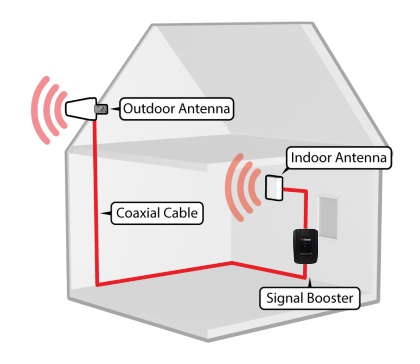
- Outside Antenna
- Repeater or Amplifier
- Inside Antenna (or connection to device)
- Power Supply
These systems are often called "repeater" type systems. The basic process is:
- The outside antenna picks up the signal from your service provider's tower.
- The signal passes through the cellular amplifier (repeater).
- The inside antenna broadcasts (repeats) the amplified signal inside.
The primary system is same whether used in a vehicle or building. The biggest difference between systems is the power of the amplifier.
3 Types of Consumer Cellular Amplifier Systems
There are 3 basic types of cell phone signal boosters. The difference between is how much area the booster system covers. The types are:
- Mobile
- Building
- Direct Connect - Machine to Machine (M2M)
Mobile Cell Phone Booster Systems
Mobile systems vary in power and design. They all need an outside antenna, amplifier, inside antenna and a power supply.
Cradle Boosters
 A Cradle type booster has a cellular amplifier built into a holder. It still has an outside antenna that picks up cell signals as you travel. Cradle Boosters are easy to install, small and have a lower cost. They are also simpler to move from vehicle to vehicle than other systems. The disadvantage of a Cradle Booster system is that they have less gain or power than other systems. They can only boost the signal to one device at a time. Your cell phone sits in the cradle to receive any benefit as well.
A Cradle type booster has a cellular amplifier built into a holder. It still has an outside antenna that picks up cell signals as you travel. Cradle Boosters are easy to install, small and have a lower cost. They are also simpler to move from vehicle to vehicle than other systems. The disadvantage of a Cradle Booster system is that they have less gain or power than other systems. They can only boost the signal to one device at a time. Your cell phone sits in the cradle to receive any benefit as well.
Cradle Booster Advantages
- Less Costly
- Simple To Move From Vehicle To Vehicle
- Easy To Install
- Holds Your Cell Phone
Cradle Booster Disadvantages
- Only Works With One Device At A Time
- Phone Must Be In Cradle
- Lower Power Than Other Systems
Mobile Repeater Type Systems
A Mobile Cellular Repeater System consists of four main components.
- Outside Vehicle Antenna
- Cellular Repeater
- Inside Antenna
- Power Supply
The outside antenna communicates with your service provider's tower. The signal passes to the repeater which amplifies the signal. The inside antenna communicates with your cell phone or another cellular device.
This "repeater" type system differs from Cradle Boosters. Repeater systems have more power (gain) so they can broadcast over a larger area inside a car or truck. Your phone or cellular data device does not have to sit in a cradle.
Advantages
- Covers Larger Area Inside Vehicle
- Device does not have to sit in a cradle
Disadvantages
- Higher Cost
- Not as Portable as a Cradle Booster
Mobile System Installation
Installation of mobile cell phone booster systems is easy. Each system requires routing a cable from outside the vehicle to the inside. Running wire is usually the most challenging part of any installation. One cable runs from the outside antenna to the amplifier. Another cable runs from the amplifier to the inside antenna on most systems. Cradle Boosters have the inside antenna built into the cradle.
Mobile Antennas
The outside vehicle antenna is usually a magnetic mount antenna. The cable runs from the antenna to a connection on the cradle. Cable from the antenna must run through a penetration point in the vehicle. The easiest entry may be through the weather-stripping around a door or trunk. You can usually pull the weather-stripping down and pass the cable underneath it. You then push the weather-stripping back into place. You can also run the cable through other openings in the vehicle. For instance, Hole (NMO) Mount antennas require drilling a hole in the vehicle's roof or trunk.
Power Options
After installing all the cable in the vehicle and connecting it to the amplifier, you can power the amp. For DC Power, you can use the DC Power Supply that comes with most systems. Plug this power supply into your car's cigarette lighter or similar power port. There are also Hardwire DC Power Kits if you want to attach the power to your vehicle's wiring. If your vehicle has AC Power (such as an RV), AC Power Supplies are also available if you prefer.
- Cigarette Lighter Power Supply
- Hardwired Into Vehicle's Wiring System
- AC Wall Outlet Power Supply
Installation Video
We have a good video of a mobile cell phone booster installation process.
Cost
There is a wide cost range for mobile signal boosters. The price can be as high as $480 for the weBoost Drive 4G-X Extended Area Booster. Different antenna options (for trucks, RVs, Boats, etc) can also add to the cost.
> Shop Mobile Cell Phone Signal Boosters
Building Systems
Mobile systems can work in your home or office. But, mobile systems only cover small areas like a few feet. They for inside your car, truck, van, RV, etc. For some people, that's enough. Add an AC power supply, maybe a different outside antenna and you have a small area building system.
If your goal is to improve signal over a larger area in a building, you'll need a system made for buildings. Building systems can improve the cell signal in a greater area than mobile systems. Building systems can cover a few rooms, a whole home, a warehouse and even multiple floor buildings.
System Components
As with mobile systems, the typical Building System consists of:
- Outdoor Antenna
- Cellular Signal Repeater
- Inside Antenna (1 or more)
- Power Supply
Building System Installation
Installing a building system is easy and straightforward. Many times running cable from the amplifier to the antennas is the most challenging part. With larger buildings, penetration points are usually available. On a home the cable is usually run from the antenna mounted on the fascia board and the cable run through a hole made in the soffit. Indoor antennas are usually mounted in the ceilings with cable running through an attic. They can also be mounts on walls.
Steps For Building System Installation
- Mount Amplifier Near a Power Outlet
- Mount Outside Antenna
- Run Cable From Outside Antenna To Amplifier
- Mount Indoor Antenna
- Run Cable From Indoor Antenna To Amplifier
- Plug In Amplifier
Each system comes with a set of full installation instructions.
Troubleshooting & Interpreting Amplifier Lights
The Lights on the amplifier will guide you in diagnosing any issues. The typical lights (depending on which system you are installing) you might see are:
- Solid Green - Amplifier Powered and at Maximum Gain
- Blinking Green & Orange - Amplifier Has Reduced Gain
- Solid Orange - Amplifier Has Powered Off Because of Too Much Power From A Nearby Cell Tower
- Solid Red - Amplifier Has Powered Off Because Of Oscillation Between Indoor and Outdoor Antennas
The included instructions with each system will give you help in troubleshooting each issue.
Cost
The cost of building signal booster systems can range from $399 for the weBoost Home 4G System, $550 for the weBoost Connect 4G (for small to mid sized homes). Larger buildings can cost well over $1,000 for commercial systems like the WilsonPro 70 System.
> Shop Building Cell Phone Signal Boosters
Direct Connect (M2M) Type Systems
In the past, many cell phones had RF ports that enabled you to connect an external antenna to them. If an antenna wasn't enough, you could connect an amplifier as well. This option is rarely available with modern mobile phones.
The Direct Connect method is still used with Machine-To-Machine (M2M) devices with good results. M2M devices are Vending Machines, ATMs, Remote Monitoring Systems, etc. They communicate using USB Modems, Hotspots, MiFi Devices and Cellular Routers.
Installation
The typical steps to installing an M2M type system are:
- Install Amplifier
- Install Outside Antenna
- Run Cable From Outside Antenna To Amplifier
- Connect Device (Hotspot, USB Modem, Router) To Amplifier
- Power Amplifier
Cost
The cost of direct connection type cellular amplifiers currently range from $160 for the Wilson Signal 3G to $250 for the Wilson Signal 4G. Additional costs can occur for different antennas, connectors and adapters.
> Shop DirectConnect (M2M) Signal Boosters
More Help & Information
Need more information? Feel free to contact us. We would be happy to help.
Recent Posts
-
weBoost Overland Signal Booster For Rugged, Off-Road Adventure
The New weBoost Drive Reach Overland The weBoost new Drive Reach Overland is the ideal booster fo …Dec 02, 2022 -
The New weBoost Signal Booster Set Up App
Installing Your weBoost Signal Booster System Just Got Easier weBoost has released a new app to he …May 20, 2022 -
The New weBoost INSTALLED Office Signal Booster System
Get A Signal Booster System - Installed At Your BusinessOffices . Retail Store …Nov 18, 2021

